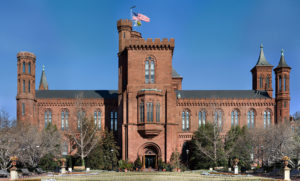Good morning.
 Friday in Whitewater will be partly sunny, with a high of eighty-three. Sunrise is 5:56 AM and sunset 8:03 PM, for 14h 06m 33s of daytime. The moon is a waning crescent with 1% of its visible disk illuminated.
Friday in Whitewater will be partly sunny, with a high of eighty-three. Sunrise is 5:56 AM and sunset 8:03 PM, for 14h 06m 33s of daytime. The moon is a waning crescent with 1% of its visible disk illuminated.
On this day in 1846, Pres. Polk signs legislation establishing the Smithsonian Institution:
The British scientist James Smithson (1765–1829) left most of his wealth to his nephew Henry James Hungerford. When Hungerford died childless in 1835,[10] the estate passed “to the United States of America, to found at Washington, under the name of the Smithsonian Institution, an Establishment for the increase & diffusion of knowledge among men”, in accordance with Smithson’s will.[11] Congress officially accepted the legacy bequeathed to the nation, and pledged the faith of the United States to the charitable trust on July 1, 1836.[12] The American diplomat Richard Rush was dispatched to England by President Andrew Jackson to collect the bequest. Rush returned in August 1838 with 105 sacks containing 104,960 gold sovereigns (about $500,000 at the time, which is equivalent to $11,491,000 in 2017).[13][14]
Once the money was in hand, eight years of Congressional haggling ensued over how to interpret Smithson’s rather vague mandate “for the increase and diffusion of knowledge.”[12][14] Unfortunately, the money was invested by the US Treasury in bonds issued by the state of Arkansas which soon defaulted. After heated debate, Massachusetts Representative (and ex-President) John Quincy Adams persuaded Congress to restore the lost funds with interest[15] and, despite designs on the money for other purposes, convinced his colleagues to preserve it for an institution of science and learning.[16] Finally, on August 10, 1846, President James K. Polk signed the legislation that established the Smithsonian Institution as a trust instrumentality of the United States, to be administered by a Board of Regents and a Secretary of the Smithsonian.[12][17]
Recommended for reading in full —
Conor Friedersdorf writes Laura Ingraham Doesn’t Love Her Country Anymore (“The Fox News host cites an increase in the numbers of legal and illegal immigrants as the reason for her diminished patriotism”):Adam Serwer contends The White Nationalists Are Winning (“Fox News anchors and high-profile politicians are now openly pushing the racism of the alt-right. The fringe movement’s messages have permeated the mainstream Republican Party”):Should she stay here rather than immigrate to a country with a whiter population that more closely approximates her preferred demographic profile, one might think her waning patriotism would jeopardize her job at a flag-waving network like Fox. But in Ingraham’s telling, a lot of her audience also feels like changes in the racial and ethnic composition of the country are causing the America that theyloved to cease to exist, so perhaps she can survive by holding onto the growing cohort of former patriots. Ratings are king.
Lest anyone worry that America won’t have enough patriots left, Ingraham is thankfully wrong when she implies that “most of us” feel as she does:
The survey by Pew Research Center, conducted June 5 through 12 among 2,002 adults, finds that 38% say legal immigration into the United States should be kept at its present level, while 32% say it should be increased and 24% say it should be decreased. Since 2001, the share of Americans who favor increased legal immigration into the U.S. has risen 22 percentage points (from 10% to 32%), while the share who support a decrease has declined 29 points (from 53% to 24%).
God bless America.
From the looks of it, the Nazis lost the battle of Charlottesville. After all, Donald Trump’s handling of the aftermath of the rally, in which he said there were “very fine people” on both sides of the protest, drew bipartisan condemnation. The attempted rebranding of white nationalism as the genteel and technologically savvy alt-right failed, the marketing campaign faltering after the murder of the counter-protester Heather Heyer and the attempted murder of several others revealed to the nation the logical conclusion of alt-right beliefs and arguments. The bloody outcome of that day foiled the white nationalists’ attempt to garner sympathy from the mainstream right, and in doing so, make themselves respectable.
But the alt-right and its fellow travelers were never going to be able to assemble a mass movement. Despite the controversy over the rally and its bloody aftermath, the white nationalists’ ideological goals remain a core part of the Trump agenda. As long as that agenda finds a home in one of the two major American political parties, a significant portion of the country will fervently support it. And as an ideological vanguard, the alt-right fulfilled its own purpose in pulling the Republican Party in its direction.
A year after white nationalists in Charlottesville chanted, “You will not replace us!” their message has been taken up and amplified by Fox News personalities. Tucker Carlson tells his audience that “Latin American countries are changing election outcomes here by forcing demographic change on this country.” Laura Ingraham says that “the America that we know and love doesn’t exist anymore” because of “massive demographic changes” as a result of “both illegal and sometimes legal immigration that progressives love.” They echo the white-nationalist claim that America is at risk because the nation is growing more diverse, an argument that treats the mere presence of nonwhite people, citizen or noncitizen, as an existential threat to the country. White nationalists like Cantwell are cheered to hear their beliefs championed on Fox. Cantwell wrote last year that Carlson “is basically telling white America to prepare for war as directly as he can get away with while remaining on Fox News.”
(One can reconcile the views of Friedersdorf and Serwer by their focus: Serwer sees that the nativist right has made gains on places like Fox, while Friedersdorf observes that the American majority yet rejects a race-laden view of citizenship.)
Conservative Michael Gerson contends The only way to save the GOP is to defeat it:If Republicans retain control of the House in November, Trump will (correctly) claim victory and vindication. He will have beaten the political performances of Bill Clinton and Barack Obama in their first midterms. He will have proved the electoral value of racial and ethnic stereotyping. He will have demonstrated the effectiveness of circuslike distraction. He will have shown the political power of bold, constant, uncorrected lies. And he will gain many more enablers and imitators.
Perhaps worst of all, a victorious Trump will complete his takeover of the Republican Party (which is already far along). Even murmured dissent will be silenced. The GOP will be fully committed to a 2020 presidential campaign conducted in the spirit of George C. Wallace — a campaign of racial division, of rural/urban division, of religious division, of party division that metastasizes into mutual contempt.
This would leave many Americans entirely abandoned in U.S. politics: Catholics who are both pro-life and pro-immigrant. Evangelicals who are conservative but think that character matters, that compassion counts, that racial healing is a Christian calling. Traditional Republicans who miss a time — not so long ago — when leaders such as Ronald Reagan and George H.W. Bush modeled grace and led the West in defending freedom.
(Gerson is a conservative who writes about the need for GOP defeat; his concern shows how far and how fast the Republican party has become a tool of Trumpism.)
Ron Brownstein observes The Ohio Results Point to Democratic Strength in 2018—And a Showdown in 2020:What You Actually See During A Meteor Shower:On balance, these sharpening divisions leave Democrats in a strong, but not guaranteed, position to win back the House by maximizing their gains in well-educated suburbs and picking off even a few Republicans outside of the major metropolitan areas. By the count of David Wasserman, the House race analyst for The Cook Political Report, there are 68 House Republican districts whose voting history leans less reliably toward the GOP than Ohio-12. “We won a district where we can nominate a bag of cement … and we won by [about] 1,000 votes,” says the longtime GOP strategist Mike Murphy, a Trump critic. “That means … they are playing 50 seats deep in our infield and almost winning. What does that tell you about our midterms?”
But Democrats will be operating with very little margin for error if they must win back the House almost solely by capturing white-collar suburban seats. Their path would be much easier if they could also win a respectable number of the Republican seats they are targeting outside of the major metro areas, including districts in upstate New York, northeastern and southwestern Iowa, downstate Illinois, California’s Central Valley, and Washington State, where Republican Representatives Cathy McMorris Rodgers and Jaime Herrera Beutler both showed weakness in Tuesday night’s primary.
….
The consistency of the voting patterns in the major elections since 2016 suggests the divisions around Trump are both hardening and nationalizing. That points toward a 2018 election in which Democrats are likely to solidify their control of the major metropolitan areas, but may struggle to establish widespread beachheads in the Republican strongholds beyond them. (If anything, Democrats have better odds of making gains on the latter battlefields than Republicans do of avoiding losses on the former.) That stark divergence promises intense conflict in Washington, D.C., after November. It also foreshadows a Trump reelection campaign in 2020 that could look like a Battle of the Bulge between what America has been and what it is becoming.


